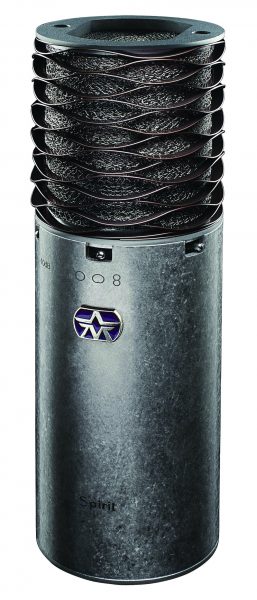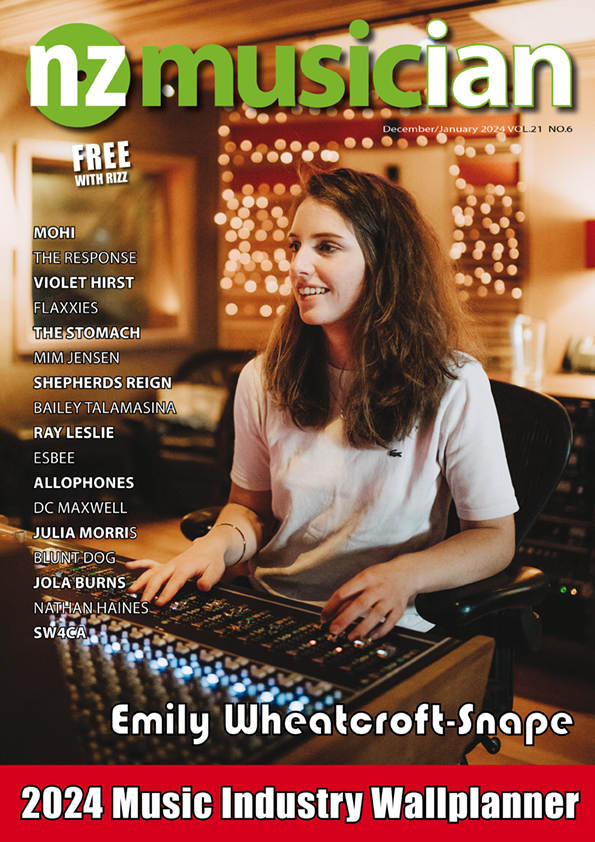Aston Spirit Condenser Microphone
Aston Spirit Condenser Microphone
When newly established British audio company Aston Microphones set out to design a new vocal recording device for an already overcrowded mid-priced microphone market, they knew they had to come up with something unique. Something that not only sounded great, but also looked different and exciting.
Enlisting a panel of 30+ experienced sound engineers they conducted double-blind listening tests at each stage of product development. The result is an offering of two microphones.
The Aston Origin is a cardioid condenser microphone with a 1” gold-evaporated capsule teamed with transformer-less circuitry.
The microphone I was given to review is the Aston Spirit, which is a multi-pattern condenser mic again with a 1” gold-evaporated capsule. A recessed switch at the top the body allows selection between omni, cardioid or figure-of-eight polar patterns. There is also a -10 and -20 db pad and a bass roll off switch. Its hand-selected capsule is matched with transformer-balanced circuitry.
 According to Aston’s promo, the Spirit is designed to deliver ‘a beautifully open sound with sparkling harmonics… giving a stunningly natural and transparent recording, capturing all the detail in the high range but without adding the harshness that some condenser microphones seem to.’
According to Aston’s promo, the Spirit is designed to deliver ‘a beautifully open sound with sparkling harmonics… giving a stunningly natural and transparent recording, capturing all the detail in the high range but without adding the harshness that some condenser microphones seem to.’
The review mic (and a matched shockmount) were accompanied by a much bigger box containing Aston’s impressive Halo reflection filter. The Halo is Aston’s take on the classic reflection filter concept for reducing room ambience in less-than-ideal recording locations. They have created a unique and eye-catching design that looks like a bubble made of bright purple acoustic foam. At $599 it is only $150 less than the Spirit mic itself (rrp $749).
So how does reality live up to the marketing? The first thing I noticed when I opened up the Spirit mic’s box is that none of the photos do it justice. It looks like no other microphone I’ve ever seen. The body of the Spirit is a mottled silver colour, a result of each chassis being tumbled for several hours, giving every microphone its own unique finish.
The grille that protects the capsule is also unique and eye-catching – it has a built-in wire mesh behind the very stylish wave-form wire frame. The mesh is designed to act as a built-in pop filter. In general, the microphone looks almost ruggedly home-made – not in a ‘quickly whipped up in the back shed’ way, more like ‘lovingly crafted by a slightly eccentric uncle who likes to pay far too much attention to detail’ way!
The day the microphone was delivered I happened to be starting an album with the Hamilton County Bluegrass Band. The band wanted to record all their instruments live in the room together then overdub vocals, which gave me a great opportunity to try the Spirit on a number of different acoustic instruments. Eventually, it found its way to the acoustic bass, where everybody really loved it. It revealed a nice tight bottom end that kept the upright bass under control while bringing out the presence of the strings when needed.
By moving the microphone up or down relative to the bridge, we could get the perfect balance of lows and attack. Interestingly, a few days later I had another acoustic bass player in the studio and the Spirit worked really well again, and this time I needed to move it much further up to get the right balance. This illustrates just how much difference the source can make.
When we got to the vocals for the Hamilton County Bluegrass Band, I tried a couple of microphone options and chose a much more expensive classic microphone to start recording male lead vocals.
Switching to female vocals we needed a different microphone. This time when I put up the Aston Spirit the singer’s voice came to life. There was a presence and air to the vocal that really shone through the mix without being harsh in any way. The low mids were still thick like the previously used microphone but now the vocal was exciting. When I switched back to the original mic for more male lead vocals I felt like something was broken. After checking every cable and connection to determine everything was working, I put the Spirit up for the male vocal and it too came alive! From that moment on, we recorded every vocal for the album on the Spirit.
On acoustic guitar, where I often prefer a small diaphragm condenser, I found the Spirit had an articulate definition on the transients while retaining a nice warm body.
I have a regular voiceover client who can be sibilant at times, but that issue was tamed when we tried the Spirit on his voice. I also took this opportunity to test out the Halo reflection filter by placing him in the centre of my room rather than in the usual voice booth. I can report that the reflection filter works as advertised, the recording came out drier than from the vocal booth.
The Aston Spirit will set you back $749 and comes with an optional shockmount for another $200. While I can see it would be possible to use the microphone without the shockmount, the position of the stand adapter on the microphone body and that fact it is not adjustable can make positioning the Spirit a bit tricky. With the shockmount you not only get the benefit of reduced rumble and handling noise, but also a much wider range of positioning options.
Having trialed the Spirit over two weeks, I found it shone on both male and female vocals. I particularly liked the way it added air and presence to female vocals. It sounded great on most acoustic instruments including acoustic guitar, mandolin, bağlama (don’t worry – I didn’t know what it was before I recorded one last week either!) and upright bass.
It’s nice to see a company striving to create something new rather than just a cheaper imitation of a classic design. It seems the listening panel knew what they were doing, as they have helped Aston create a unique looking and excellent sounding microphone. Their Spirit is priced for the project studio but it would be just as at home in a high-end setting.
Dave Rhodes is a Tui award winning sound engineer and the Studio Manager at Depot Sound recording studio in Devonport. In 20 years recording Dave has worked with most styles of music and is enthusiastic about encouraging and recording new artists as well as established bands. This year the Warratahs’ album he recorded won Best Country Album at the 2016 VNZMA. www.depotsound.co.nz
